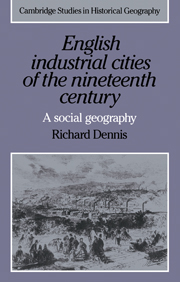Book contents
- Frontmatter
- Contents
- List of Figures
- List of Tables
- Preface
- A note on prices and distances
- 1 Urban geography and social history
- 2 Sources of diversity among Victorian cities
- 3 Contemporary accounts of nineteenth-century cities
- 4 Public transport and the journey to work
- 5 The geography of housing
- 6 Class consciousness and social stratification
- 7 The spatial structure of nineteenth-century cities
- 8 Residential mobility, persistence and community
- 9 Community and interaction
- 10 The containing context
- Notes
- Bibliography
- Index
- Frontmatter
- Contents
- List of Figures
- List of Tables
- Preface
- A note on prices and distances
- 1 Urban geography and social history
- 2 Sources of diversity among Victorian cities
- 3 Contemporary accounts of nineteenth-century cities
- 4 Public transport and the journey to work
- 5 The geography of housing
- 6 Class consciousness and social stratification
- 7 The spatial structure of nineteenth-century cities
- 8 Residential mobility, persistence and community
- 9 Community and interaction
- 10 The containing context
- Notes
- Bibliography
- Index
Summary
The origins of this book lie in research undertaken at Cambridge from 1970 to 1973 with the support of a Social Science Research Council studentship. My first intention was to write a book which set that research in the context of other recent geographical studies of nineteenth-century cities. But as the thesis became part of my own social history so the research of others, especially non-geographers, assumed more significance. So the book has become a critical review and reassessment of my own and others' recent research, considered in the light of a wider canvas of historical and contemporary observation. As I have succumbed to the humanising influence of colleagues at University College, so I have tried to marry the positivism that comes most naturally to a consideration of what contemporary observers - diarists, journalists, novelists - thought about their cities. The theme of my doctoral research had been that ‘social area analysis’ had produced too restricted a view of the social geography of Victorian cities. Even within the framework of positivist, statistical analysis, alternative and more dynamic interpretations of community structure were possible. This book takes the argument a stage further: ‘community’ and ‘segregation’ are not alternative ways of interpreting urban structure, but opposite sides of the same coin. We cannot study one independently of the other. To demonstrate this complementarity I have relied heavily on the work of others and I am especially grateful to Keith Cowlard, Stephen Daniels, Martin Daunton, Alan Dingsdale, Martin Gaskell, John Jackson, Colin Pooley, Jane Springett and Iain Taylor, who allowed me to quarry their doctoral theses for comparative data, ideas and arguments.
- Type
- Chapter
- Information
- English Industrial Cities of the Nineteenth CenturyA Social Geography, pp. xi - xiiPublisher: Cambridge University PressPrint publication year: 1984

